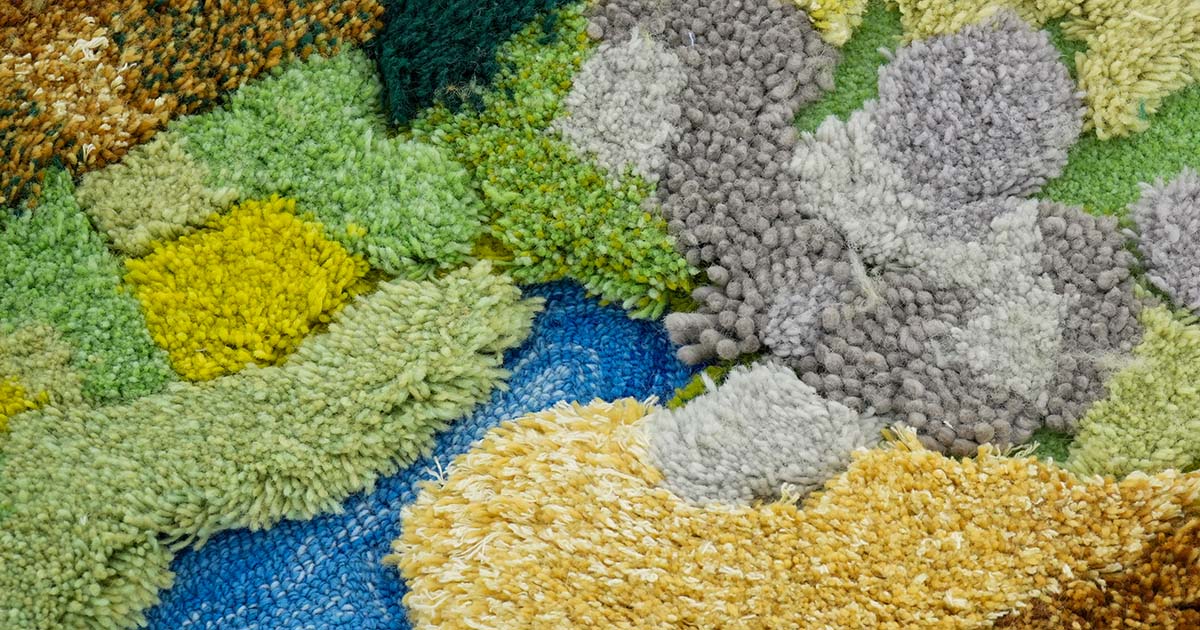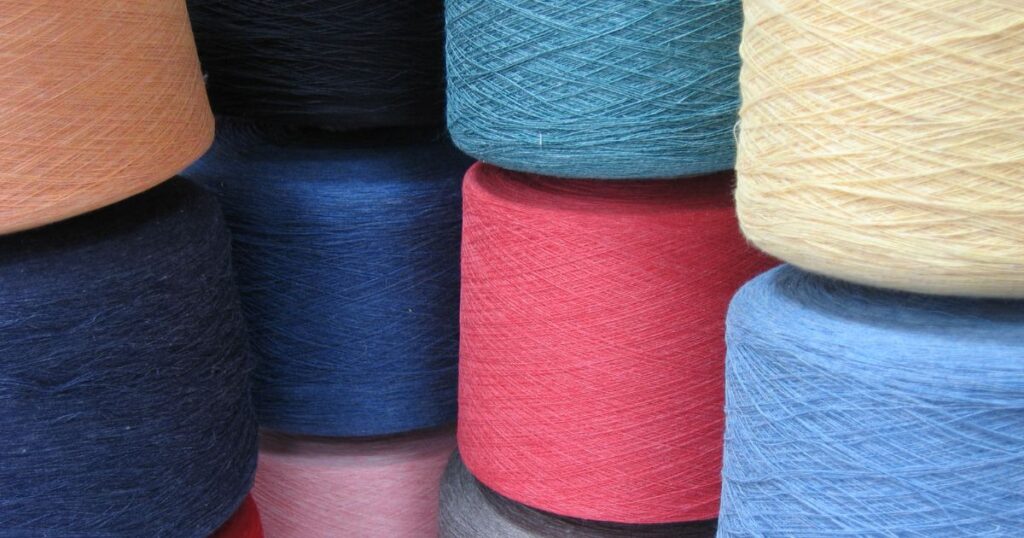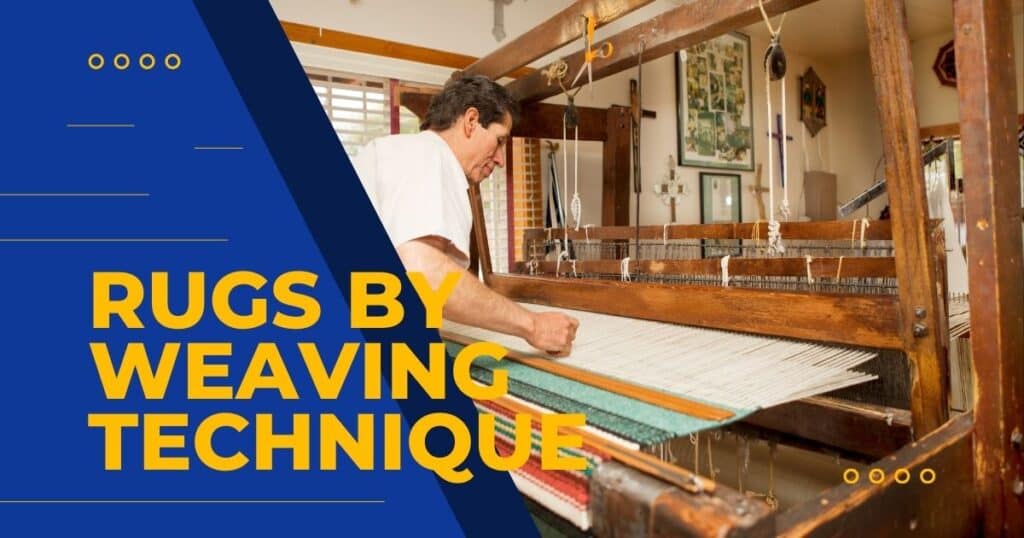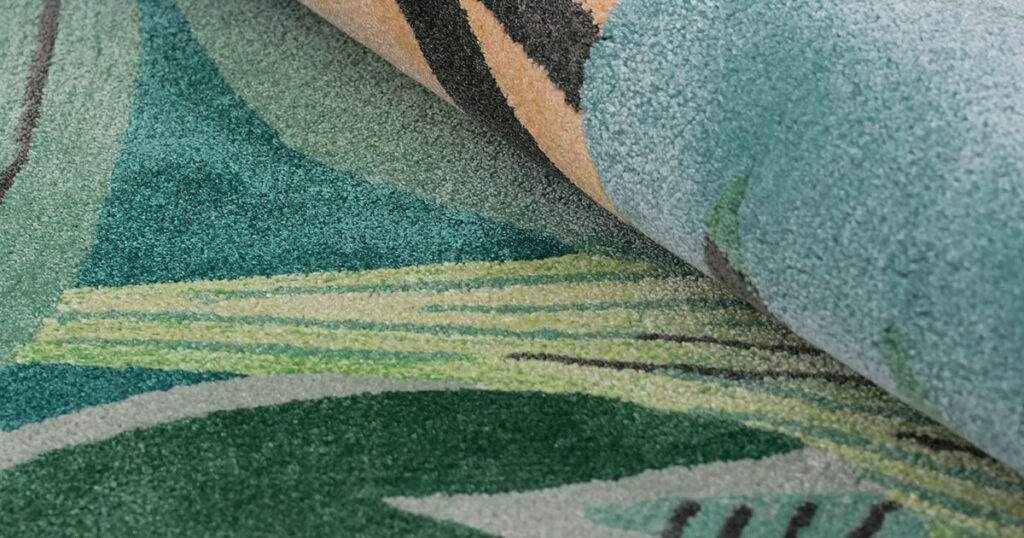When sourcing custom tufted rugs, understanding pile construction is essential.
This guide explains the fundamentals of rug pile types, height, and density.
These factors determine both appearance and performance of your custom rug.
Tufted Rug Construction Basics
Tufting is the dominant method for manufacturing commercial carpets. Approximately 95% of commercial carpets are created through tufting processes. This method offers several key advantages:
- Faster production times
- Lower manufacturing costs
- Greater design flexibility
- Support for various styles and patterns
In tufted construction, yarn is punched through a primary backing.
This forms the carpet’s pile.
A secondary backing with adhesive locks the tufts in place.
The process allows variation in pile heights and different tuft styles.
Tufted rugs provide an excellent balance of durability, cost-effectiveness, and design versatility.
This makes them suitable for offices, hospitality settings, retail environments, and homes.
Cut Pile & Loop Pile
The term “pile” refers to the yarn that forms the surface of a rug.
These are the tufts you see and feel on the carpet surface.
Tufted rugs come in three basic pile constructions:
Cut Pile
In cut pile carpets, yarn loops are cut at the tips. This creates upright fiber tufts with exposed ends. The result is a smooth, velvety surface that feels soft underfoot.
Appearance
Cut pile rugs have a luxurious, plush appearance. They create an elegant look in any space. Common cut pile styles include plush Saxony carpets with a dense, uniform finish. Twist or Frieze carpets offer a textured, casual finish from highly twisted yarns.
Best Applications
- Hotel guestrooms and luxury suites
- Executive offices
- High-end retail boutiques
- Residential living rooms and bedrooms
- Areas where comfort or upscale aesthetics are priorities
Performance Characteristics
- Provides a soft, comfortable feel underfoot
- Less resistant to crushing than loop pile in high-traffic conditions
- Exposed fiber ends may fray or crush over time with heavy foot traffic
- Quality materials and proper density are essential for maintaining appearance
- High-quality cut pile carpets can withstand moderate traffic
- May show footprints or matting in very busy areas
- Cut pile in commercial settings works best in lower-traffic areas
- Design techniques like mottled colors or patterns help hide wear
Loop Pile
Loop pile carpets keep the yarn uncut. This forms continuous loops on the surface. The result is a textured, knit-like appearance since you see the looped side of the yarn.
Appearance
Loop pile (often called “Berber” in residential markets) creates a textured, uniform surface. The loops create a distinctive knitted appearance. This can range from casual to refined depending on construction.
Best Applications
- High-traffic commercial areas
- Office corridors and open-plan offices
- Airport or retail flooring
- Education or healthcare facilities
- Carpet tiles for workplaces
- Areas requiring robust performance and easy maintenance
Performance Characteristics
- Firm and highly durable construction
- Extremely resilient because looped construction distributes weight evenly
- Resists crushing and matting, even with heavy foot traffic
- Stands up well to rolling loads like desk chairs or carts
- Hides footprints and vacuum marks effectively
- Dirt tends to sit on the surface rather than deep in the pile
- Easier to clean as debris doesn’t get trapped between fibers
- Firmer texture underfoot compared to cut pile
- Loops can potentially snag (more relevant in residential settings)
- If a loop breaks in commercial use, it could cause a carpet run
For durability and low maintenance, loop pile is often the preferred construction in commercial spaces.
Pile Height
Pile height is the length of the fiber tufts measured from the primary backing to the tip. Simply put, it indicates how tall or short the carpet pile is.
This specification directly impacts both the appearance and performance of a rug. Pile height is typically expressed in:
- Fractions of an inch
- Millimeters (mm)
How Pile Height Affects Appearance and Feel
Higher Pile
- Creates a more plush, cushioned feel underfoot
- Provides a luxurious look with a “deep” or fluffy appearance
- Similar to shag or thick plush rugs
Lower Pile
- Appears flat and dense with a firmer feel
- Gives a more tailored, smooth appearance
- Provides a more professional, uniform look
Medium Pile
- Offers balance between softness and practicality
- Provides some cushioning without excessive thickness
Effect on Durability & Maintenance
Lower Pile Heights
- More suitable for high-traffic commercial areas
- Less material to mat down or crush under foot traffic
- Typically holds up longer under constant use
- Easier to clean as vacuums remove dirt more effectively
- Better for areas with rolling furniture or equipment
Higher Pile Heights
- Can flatten in busy areas and show traffic patterns
- More difficult to clean as dirt sinks deeper into fibers
- Better suited for low-traffic, residential areas
- Often used in decorative rugs or luxury spaces
Typical Pile Height Measurements
While there’s no absolute standard, these general categories apply:
Low Pile
- Approximately 3-6 mm (0.125-0.25 inch)
- Common in commercial carpets and carpet tiles
- Prioritizes durability and easy maintenance
- Ideal for most high-traffic business environments
Medium Pile
- Approximately 6-12 mm (0.25-0.5 inch)
- Found in many commercial broadloom installations
- Used in residential carpets balancing comfort and durability
- Good compromise for mixed-use areas
High (Deep) Pile
- Above 12 mm (0.5 inch or more)
- Used in luxury residential rugs or hospitality carpets
- Creates plush, comfortable environments
- Not ideal for heavy traffic areas
- A dense 0.5″ cut-pile feels luxurious in a hotel suite
- Would not be suitable for hotel corridors with rolling luggage
Most commercial tufted rugs use lower or medium pile heights for performance needs. Industry guidelines confirm that lower pile heights better sustain high traffic without crushing.
When selecting pile height, consider:
- Door clearance requirements
- Foot traffic intensity
- Cleaning regiment
- Furniture movement needs
- Desired aesthetic and feel
For high-traffic commercial installations, shorter pile heights enhance durability and ease of maintenance.
Pile Density
Pile density refers to how much fiber material is packed into the carpet pile. It measures the compactness of the yarn tufts relative to area and height.
Density is a crucial factor in a rug’s performance, especially for commercial durability. Several construction parameters influence density:
- Gauge (spacing) of tufting needles
- Number of stitches per inch
- Yarn thickness
- Pile height
Practically speaking, a carpet with more yarn or stitches per unit area will be denser and usually more resilient.
How Density is Measured
Density can be expressed in different ways:
Tufts per Unit Area:
- The number of yarn tufts in a given area (e.g., per square inch)
- Higher numbers indicate more closely packed tufts
Why Density Matters
Density directly affects how well a carpet wears over time:
Low-Density Carpets
- Fibers have more space between them
- Under traffic, fibers bend and crush into empty spaces
- This leads to flattened appearance or visible “wear paths”
- More susceptible to showing traffic patterns
High-Density Carpets
- Fibers support each other better
- Springs back more readily after compression
- Retains height and appearance longer under use
- More resistant to crushing and matting
For a given carpet material and weight, a lower pile height combined with higher stitch count yields a denser, more durable carpet.
This explains why commercial carpets often pair shorter pile with heavier yarn weight.
Commercial Density Recommendations
For heavy-use commercial settings, industry experts recommend higher density carpets:
Very High Traffic Areas
- Busy hotel lobbies or convention center hallways
- Should have density indices of 5000 or above
- Focuses on maximum durability and appearance retention
Moderate Traffic Areas
- Less busy spaces may use moderate density
- Especially effective when paired with quality fiber types
- Balance of comfort and performance
Remember that density works together with fiber type and pile height. A modest density carpet can perform well with resilient fiber (like quality nylon) and low pile height. Even high-density plush carpet in poor fiber might show premature wear.
When reviewing rug specifications, pay close attention to:
- Pile density values
- Face weight measurements
- Tufting gauge specifications
A dense tufted rug will better withstand commercial use rigors.
Don’t hesitate to ask suppliers for specific density values or component specifications.
Higher density often means a firmer feel underfoot, but this trade-off supports longevity in busy spaces.
Selecting the Right Specifications
Every project has unique requirements. Understanding pile types, height, and density helps you specify a tufted rug that meets both performance and design needs. Consider these factors when evaluating suppliers:
Match Pile Type to Usage
Think about your environment and aesthetic goals:
For Luxury Settings with Significant Traffic:
- Luxury hotel lobbies or corporate boardrooms
- Consider cut-and-loop pile carpets
- They offer high-end appearance with patterns that hide wear
For Very Busy Functional Spaces:
- Open-plan offices or classrooms
- Dense loop pile carpet in carpet tiles work well
- Provides durability and easy replacement when damaged
For Boutique or Comfort-Focused Areas:
- Retail spaces or hotel guest rooms
- Well-constructed cut pile rugs
- Convey warmth and luxury to clients or guests
Always balance comfort versus durability in your selection:
- Loop piles prioritize durability
- Cut piles prioritize comfort
- Combination piles offer middle ground
Specify Appropriate Pile Height
Ensure the pile height suits the location’s needs:
For Heavy Traffic or Functional Areas:
- Office corridors, restaurants, healthcare facilities
- Choose low pile height (3-6mm)
- Improves wear resistance and simplifies maintenance
For Comfort-Focused Spaces:
- Lounge areas or executive suites
- Freedom to use taller pile for richer feel
- Balance luxury with practical requirements
Be mindful of practical constraints:
- Door clearance requirements
- Potential tripping hazards
- Maintenance equipment compatibility
- Furniture movement needs
Prioritize Density for High-Traffic Areas
For intense-use areas, focus on pile density:
Heavy-Use Commercial Spaces:
- Hotel hallways, airports, department store floors
- Prioritize products with high pile density (5000+ index)
- Ensures longevity and appearance retention
Specification Questions for Suppliers:
- What is the face weight and density of this rug?
- How does it compare to industry standards for my application?
- Commercial broadloom in busy corridors typically has 30+ oz/yd² face weight
- Density values should exceed 5000 for high-traffic applications
Be cautious if a supplier’s product has significantly lower density than typical for your use-case.
This may indicate potential for premature wear.
Consider Combination Designs for Balanced Performance
For both design requirements and performance needs:
Strategic Pile Combinations:
- Specify cut-and-loop patterns with moderate pile height and high density
- Many custom hospitality carpets use this approach
- Place more durable loop yarns in high-wear portions of the pattern
- Use cut-pile accents for visual interest or branding elements
Design Consultation:
- Discuss with manufacturers how patterns support functional needs
- Ask how tufting technology can create designs without sacrificing performance
- Request samples showing pattern capabilities in your chosen construction
Evaluate Supplier Expertise
A capable OEM rug supplier should provide detailed specifications and recommendations. Use your knowledge to ask informed questions:
Example Questions:
- What pile construction do you suggest for a hotel ballroom with banquet chair traffic?
- Why do you recommend this specific construction?
- Can you provide density and face weight specifications?
- What is your tufting gauge for this construction?
A knowledgeable supplier might respond with specific recommendations like “a solution-dyed nylon level-loop, low pile, density ~6000 for maximum durability” and explain their reasoning.
Verification Steps:
- Request samples to feel texture and thickness
- Compare supplier specification sheets
- Look for detailed technical information: pile height, face weight, density, tufting gauge
- Ensure specifications align with your project requirements
Choosing a supplier transparent about technical details builds confidence that the delivered rug will meet your standards.
Take the Next Step
Ready to apply this knowledge to your custom rug project? Contact a reputable manufacturer today. Share your specific requirements and environment details.
Request samples of different pile types to compare textures and densities. Ask for detailed specifications and performance expectations for your unique application.
The right tufted rug combines visual appeal with practical performance. Understanding pile types ensures you make a confident, informed selection.




